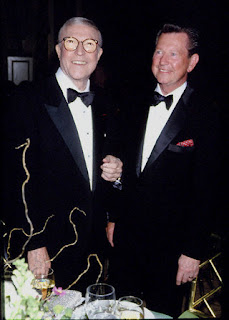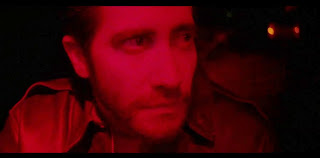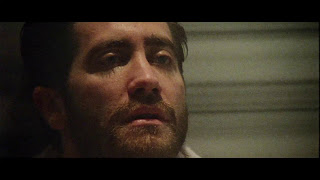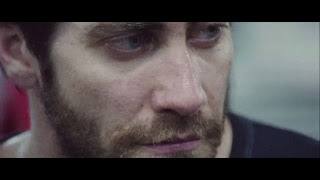Cosmo Brown (Donald O'Connor) sings about the merits of being a comedic actor in "Singin' in the Rain" (1952). Cast: Gene Kelly, Donald O'Connor, Debbie Reynolds, Jean Hagen Director: Stanley Donen, Gene Kelly
 "It's not easy working with a genius - but Gene was very patient with me." -Donald O'Connor (1988) on his "Singin' in the Rain" co-star, Gene Kelly
"It's not easy working with a genius - but Gene was very patient with me." -Donald O'Connor (1988) on his "Singin' in the Rain" co-star, Gene Kelly Donald O'Connor Interview for Warner Home Video ("Singin' in the Rain" 50th anniversary):
Donald O'Connor Interview for Warner Home Video ("Singin' in the Rain" 50th anniversary):-Your signature number in "Singin’ in the Rain" is “Make ‘Em Laugh.” How did it develop? Did you work with the choreographer to add all the wonderful bits of business?
 Gene Kelly and Donald O'Connor attending The American Ireland Fund Gala Dinnery on November 19, 1992
Gene Kelly and Donald O'Connor attending The American Ireland Fund Gala Dinnery on November 19, 1992-Donald O'Connor: When Gene got the music for “Make ‘Em Laugh” he said to me, “Why don’t you take the girls”— by which he meant his assistant choreographers — “and see what you can come up with?” So I got a pianist and took the girls into a rehearsal hall, and I began to sing and did a pratfall. They laughed, and I said, “Write that down.” Whatever they laughed at the most, that’s what we did on the screen.
 -How long did it take to film “Make ‘Em Laugh”?
-How long did it take to film “Make ‘Em Laugh”?-Donald O'Connor: I had to do it in one day, because I was doing those pratfalls on cement, and my body — my knees, ankles, and toes — everything started to hurt. We saw right then that we had to shoot fast, and we did. It was absolutely miraculous. Two days later, when I walked onto the set, I got applause from everyone with the lights way up high, like the opening of a Broadway show. Stanley said, “That number is just great. Do you think you could do it again”’ It turned out the aperture on camera had been open too wide, and the whole number was fogged out. I looked like a ghost.
 -Other than the title song, “Make ‘Em Laugh” is the most memorable number in the movie. It was generous of Gene Kelly to let another actor have the showstopper.
-Other than the title song, “Make ‘Em Laugh” is the most memorable number in the movie. It was generous of Gene Kelly to let another actor have the showstopper.-Donald O'Connor: I think so, too. It shows you the true character of this man. He was not afraid of competition. He wanted it, and he was happy when you were better than he was, not only professionally but personally. He loved the idea that someone was working hard and paying attention.
 -Debbie Reynolds was quite young and inexperienced when she signed on for Signin' in the Rain, compared to you and Kelly. Did that make things difficult during the filming?
-Debbie Reynolds was quite young and inexperienced when she signed on for Signin' in the Rain, compared to you and Kelly. Did that make things difficult during the filming? Donald O'Connor and Debbie Reynolds in "I Love Melvin" (1953) directed by Don Weiss
Donald O'Connor and Debbie Reynolds in "I Love Melvin" (1953) directed by Don Weiss-Donald O'Connor: Debbie was quite a remarkable girl. She was so giving and so open that you wanted to take her into your arms. At the same time, she had experienced enough rejection in her life to make her interesting. It was hard to believe she'd never taken dance lessons before 'Singin' in the Rain', but she hadn't. She had to learn all that stuff with Gene and me really pushing her, because we only had a limited amount of time to prepare for the film. But she picked up on everything and managed to keep up with us. I can't imagine who else they could have gotten who would have been as perfect for that part.
 -The stunts you do in “Make ‘Em Laugh” are fantastic, even by today’s standards. Did you have any acrobatic training?
-The stunts you do in “Make ‘Em Laugh” are fantastic, even by today’s standards. Did you have any acrobatic training? -Donald O'Connor: I come from a circus family. We were in vaudeville. That’s where I learned everything. As soon as I was born, I joined the act. I started out dancing and singing a little bit, then I worked up to acrobatics. The family taught me how to balance on my hands. But after my sister was hit by a car and killed, the family became overly protective with me. So I never got to learn all those great tumbling tricks that my brothers Billy and Jack could do. But I did pick things up as I went along. I brought in Jack to teach me how to do all those flips in “Make ‘Em Laugh.”
-Donald O'Connor: I come from a circus family. We were in vaudeville. That’s where I learned everything. As soon as I was born, I joined the act. I started out dancing and singing a little bit, then I worked up to acrobatics. The family taught me how to balance on my hands. But after my sister was hit by a car and killed, the family became overly protective with me. So I never got to learn all those great tumbling tricks that my brothers Billy and Jack could do. But I did pick things up as I went along. I brought in Jack to teach me how to do all those flips in “Make ‘Em Laugh.” -When you made Singin’ in the Rain, did you ever envision that you would be talking about it in a forum like this 50 years later?
-When you made Singin’ in the Rain, did you ever envision that you would be talking about it in a forum like this 50 years later?-Donald O'Connor: No one ever thought it would be this big, though we all knew it was going to be a wonderful picture, because everybody worked so hard on it. Then, when it started taking off, of course everybody was excited. Now, with this new DVD format, it’s a kick to see it coming alive again in a new way. Source: video.barnesandnoble.com
 Donald O'Connor and Marilyn Monroe arriving at the “Call Me Madam” premiere (1953)
Donald O'Connor and Marilyn Monroe arriving at the “Call Me Madam” premiere (1953) Donald O'Connor singled out his favorite performance "Call Me Madam (1953): "my favorite number is in there with Vera Ellen. It's the number I do out in the garden with her to 'It's a Lovely Day Today'. It's a beautiful lyrical number. I think she was the best dancer outside of Peggy Ryan I ever danced with."
Donald O'Connor singled out his favorite performance "Call Me Madam (1953): "my favorite number is in there with Vera Ellen. It's the number I do out in the garden with her to 'It's a Lovely Day Today'. It's a beautiful lyrical number. I think she was the best dancer outside of Peggy Ryan I ever danced with." His 1944 marriage to Gwendolyn Carter ended in divorce 10 years later.
His 1944 marriage to Gwendolyn Carter ended in divorce 10 years later.  They had a daughter, Donna.
They had a daughter, Donna. His second marriage, to Gloria Noble in 1956, lasted for the rest of his life. They had three children, Alicia, Donald Frederick and Kevin.
His second marriage, to Gloria Noble in 1956, lasted for the rest of his life. They had three children, Alicia, Donald Frederick and Kevin. Donald O'Connor and Judy Garland rehearse for premiere production of "The Judy Garland Show," their first TV appearance together.
Donald O'Connor and Judy Garland rehearse for premiere production of "The Judy Garland Show," their first TV appearance together. Donald O'Connor as Milton Haskins, Martha Stewart as Bunny La Fleur and George O'Hanlon as Buster, performing the musical number "Daddy, Surprise Me" in "Are You with It?" (1948)
Donald O'Connor as Milton Haskins, Martha Stewart as Bunny La Fleur and George O'Hanlon as Buster, performing the musical number "Daddy, Surprise Me" in "Are You with It?" (1948) Mr. O'Connor prided himself on being forward-looking, and he was not inclined to dwell on his past. "I'm no longer a superstar," he said in 1992. "Now I'm working on being a quasar, because stars wear out. Quasars go on forever." Source: www.nytimes.com
Mr. O'Connor prided himself on being forward-looking, and he was not inclined to dwell on his past. "I'm no longer a superstar," he said in 1992. "Now I'm working on being a quasar, because stars wear out. Quasars go on forever." Source: www.nytimes.comJoseph Gordon-Levitt - SNL Opening Monologue ("Make 'Em Laugh") On November 21st, 2009
 He explained that "Singing In The Rain" is his all-time favorite musical and that he's always had a fascination with the song "Make 'Em Laugh."
He explained that "Singing In The Rain" is his all-time favorite musical and that he's always had a fascination with the song "Make 'Em Laugh."
























































